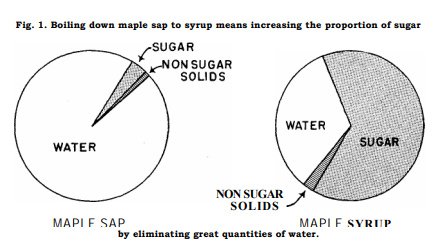The sap is flowing!
The sap has been flowing intermittently the past couple weeks, and oh what a delight to hear that plunk plunk sound of the first drips hitting the bottom of an empty sap bucket. The sap slowly changes flavors across the sugaring season (more on that next week), but it also changes across the whole year. Here I’ll explain a bit about what’s in sap and how this varies from tree to tree.
A year in the life of sap
During photosynthesis, leaves use energy from the sun to convert water and carbon dioxide into “photosynthate,” or the simple sugar glucose. These sugars are rapidly converted into another slightly more complex monosaccharide (fructose) or combined with fructose into the disaccharide, sucrose, in the cytoplasm adjacent to the chloroplasts. Most of these simple sugars are used by the leaf for general maintenance, repair, metabolism, or defense during the growing season. But excess sugars can also be glommed together into polysaccharides, or chains of sugars, like cellulose (which is the primary component of wood) or starch. Rather than pipe starches from the leaves down the trunk for winter storage, a tree mostly transports sugars in their simpler form (e.g. glucose, fructose and/or sucrose) and then converts these sugars into starch for winter storage in situ.
Starch stores are slowly drained in the fall, winter, and spring and so sugar content in a tree slowly declines during the colder moths. The concentration of these non-structural sugars (cellulose is a structural sugar) may drop about 25-35% from their peak during the summer months to the end of winter when stored sugar is at its lowest. Not surprisingly, the farther north you go, the larger this gap gets, and, as in paper birch, the difference between winter and summer sugar content can be as much as 72% (source). This is a lot like how a squirrel might plow through its fat reserves through the winter.
The non sugar solids are a range of metals (e.g. zinc, magnesium, iron, etc.), salts (e.g. sodium), and other minerals
Since starch – unlike glucose, fructose, and sucrose – is not water soluble, it can be stored in cells without affecting water concentrations. And since water moves from areas of high concentration to low concentration, storing sugar as a starch stabilizes water within and between cells while the tree is dormant. In the fall and winter, most of the non-structural sugars are in the form of these more stable starches. Because the sugar is not dissolved in water, winter-stored starches are less accessible to insects with sucking mouth parts.
Early in the spring (or late in the winter depending on if your cup is half full or half empty), the tree begins to produce amylase, that same enzyme in your saliva that begins to predigest your food. Amylase begins to be break down starches stored throughout the tree into glucose, fructose, and/or sucrose (depending on the genus – maples are mostly sucrose, birches glucose, fructose, and sucrose: source), which allow for the sugars to be transported back towards the buds where they’ll fuel the early spring growth of leaves and flowers.
A quick note on the other stuff in sap
Sap has more than just sugar in it, and much like the concentration of sugar across the growing season, the concentration of these non-sugar solids can change as well. These may include phenolic compounds (like photo-protective pigments), minerals (like zinc, calcium, sodium, magnesium, etc.), organic acids (like malic acid, which promotes growth), and amino acids.
Sugar content of various trees
There’s a range of sugar concentration both across species lines and in trees within a given species. The sap of sugar maple, for example, ranges somewhere around 3-8% sugar. Since syrup is around 67% sugar, you need to boil about 40 gallons of sap down to 1 gallon of syrup. Paper birch sugar concentration is 1-2% and requires well over 100 gallons of sap to make a gallon of syrup. There isn’t great data for most species, but the following are rough estimates of the sugar concentrations in sap for different species (source, source, source):
- Red maple = 4%
- Amur maple = 3.9%
- Silver maple = 3.5%
- Boxelder = 2.5%
- Black walnut =2-3.5%
- Paper birch = 1-1.5%
- Yellow birch = 0.5%
- American sycamore = 0.5%
Variation within a species (and within a tree across seasons)
Back in the 40s and 50s, researchers at the Proctor Maple Research Center studied the sugar concentration in sap from sugar maples. The long-term survey of sugar concentration in sugar maples shows just how variable the concentration can be between trees and within a single tree across various years. Over the 10 years of measurements, the sugar concentration changed by as much as 5 percentage points in some trees! It’s not entirely clear what the root cause of all that variation is, but it’s likely a combination of genetics, local growing conditions, and seasonal variation in climate.







